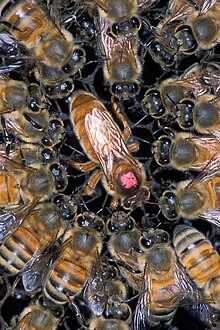Bumble bees are a species of large bees. Queen bees spend their lives inside the hive except for swarming and mating.
Each hive only has one permanent queen. They live about 4 years and one mating with several drones is sufficient for the queen to lay some 1500-2000 eggs per day for most of her life. When gets old the hive kills the queen and installs a new one.
https://bugguide.net/node/view/3077
Bumblebees are a genus, with a couple of hundred different species.
These species come in different sizes, some large and others smaller - the species also have different tongue lengths, some longer and others shorter, adapted to (and specializing in) the nectar and pollen sources in their region. The tongue length is not completely correlated with the body size, between the various species.
They do not, in general, swarm. The hives are not that big, and new hives are started by new and solitary queens every spring.
The hives do not, in general, kill their queens.
The hives and their generating queens do not, in general, survive the winter after they build a hive - the only survivors are the hibernating new queens, which the hive has produced instead of honey stores. They do make honey - but they feed it to new queens rather than store it to get them through the winter. So the queens - the longest lived - live one summer in the temperate zones.
As a genus, they are more capable pollinators of native NA temperate zone plants than honey bees - they fly in colder weather, have the physical strength to handle more different kinds of flowers efficiently, and use a wider variety of techniques to harvest (and pollinate) - including buzzing and vibrating at the right frequency to shake loose the pollen of particular flowers.




